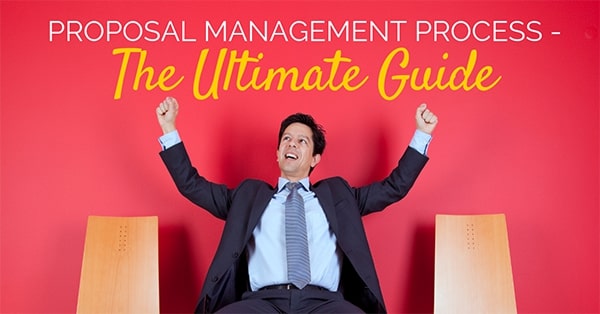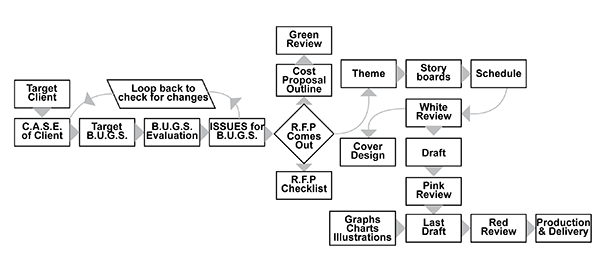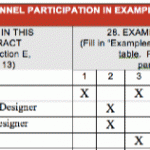
The right proposal management process is essential to any successful proposal writing effort. Yet, people often struggle to set up a process that works. And they end up becoming frustrated with proposal management.
In this post, I’ll break down what a proposal management process is, how to determine which process is best for your situation, and the typical steps that go into proposal management.
Plus, we’ll even touch on some proposal management best practices.
But first, let’s talk about why people get so frustrated with proposal management.
My Research Into Proposal Management Frustrations
Several years ago, I decided to conduct my own little research study. I collected over 1,000 data points from proposal coordinators and managers across the U.S. on what their biggest frustrations, challenges, and roadblocks were.
I did face-to-face meetings and phone interviews. I sent out surveys and I started discussions in LinkedIn groups and other online forums.
Yes, no sane, rational human being would spend large amounts of his or her personal time collecting data on why proposal management sucks. But that’s exactly what I did. I’ll admit it, I’m a weirdo. I’ve collected what I believe to be the definitive data set on this topic.
The Common Themes
Not surprisingly, firms big and small commonly suffer from a few core frustrations. Let me introduce you to the frustrations your peers share with you (even if they won’t always admit it):
- Slow Go/No Go Decisions
- Late Delivery From The Technical Staff
- Lack of Trust, Respect, and/or Appreciation
With the right proposal management process, these problems tend to go away.
What is the Proposal Process?
An overall proposal process typically includes at least these three elements.
- Pre-RFP (Request For Proposal)
- Planning And Managing The Proposal Development
- Writing The Proposal
Here’s a proposal process flowchart from Laura Ricci’s book, the Magic Of Winning Proposals.

At first glance, it looks awful complex. But when you consider Shipley’s 96-step process, Laura’s seems a heck of a lot more manageable.
Proposal Managers aren’t typically involved during the Pre-RFP phase. That effort is usually taken care of by “capture managers” or “business developers.” Proposal managers are responsible for ensuring a successful planning and writing effort.
So, a proposal management process is a subset of a larger overall process. But that doesn’t mean it is not important. In fact, to respond to a complex RFPs which require input from multiple parties, you’ll need a solid proposal management process that works for you.
Why It’s Important To Have A Proposal Management Process
When I talk about a Proposal Management Process, I’m referring to a written document that proposal managers can measure their efforts against.
A lot of firms think they have a process but will often claim it is safely stored in someone’s head. The fact is, if it’s not written down…it doesn’t exist.
Without a proposal management process, you can expect embarrassing mistakes, wasted time, lost contracts, and frustrations as I mentioned earlier.
While it might seem like a pain in the butt, setting up and following a written process makes your life ten times easier.
Now, based on my experience, there is not a single process that work’s for every business. Therefore, it is up to you to create a process that fits your firm’s situation and needs.
With that said, there are basic steps that should be addressed in every proposal management process. Don’t worry, I’m going to walk you through each step.
Proposal Management Process Steps
We’ve talked about an overall proposal process. But let us get specific. Here are the proposal management steps you need to systemize within your process.
Step One: Go/No Go Decision
Before you write your proposal, you have to determine not only whether the opportunity is a good fit, but whether you can reasonably compete. Essentially, you must figure out what game is being played and whether it makes sense for you to play it.
Even though nobody can accurately predict the future, in most situations you’ll be able to determine whether or not your firm has a reasonable shot at winning.
Therefore, it is essential to define the criteria needed to be considered for a go/no go decision. But it is also critical to identify who makes these decisions and how quickly that person needs to turn around his/her decision. You should also include what to do if that person is on vacation.
Remember, we’re not just defining what is done during each step. We’re defining the who, what, when, where and why for each task.
Step Two: Proposal Planning
After you’ve made the decision to submit a proposal, it’s time to start planning. Proposal planning includes identifying tasks and individual responsibilities, developing a winning strategy, drafting a proposal outline, creating the schedule, and coordinating with subconsultants/contractors.
How is all of this going to work? Who is going to do what, when, and how?
You need an unambiguous plan for every proposal effort. Therefore, your proposal management process needs to be very clear about how the planning will be done.
Step Three: Kick-Off Meeting
Once you’ve started planning your effort you’ll need to gather everybody who is going to contribute to the effort and make sure everyone knows what to do and is on the same page. This is referred to as a “kick-off meeting.”
Your process needs to identify what needs to happen prior to the kick-off meeting. For example, is everyone going to read the RFP before the meeting? If you don’t have a proposal management process that requires people to read the RFP and reminds them…it simply won’t happen. So, make sure everything that needs to occur before the kick-off meeting is defined within your process.
You’ll also need to define what is discussed during each kick-off meeting. This might include a standard meeting agenda. At the very least, you’ll want to touch on who will write which sections, what the deadlines are, which team members will be proposed, and your strategy for winning.
Step Four: Proposal Development
Proposal development is all about putting your plan into action. At this point, you have an outline. You know who is going to write what by when.
Proposal development is when you write the proposal, design the document, create graphics and images, and put together the numbers. It’s when the “sausage is made.”
There are key considerations during this step. There are actually different approaches to writing proposals. Laura Ricci taught the world the value of storyboarding your proposal. Carl Dickson promotes the use of “proposal recipes.” And unfortunately, others simply revise existing boilerplate material.
Regardless of your writing approach, the individuals responsible for writing will likely need (or at least appreciate) some material to help them get started or guide them. Your proposal management process should address what people will be provided.
During the proposal development, there will also inevitably be some reviewing and editing. Some firms use a standard “color team” review process. But color team reviews is not the only method out there. How will you ensure quality and effectiveness in your proposal? That’s another example of what you need to include in this section.
There are also other strategies you can add your proposal development, like dummy books and final
Regardless, this step is where the rubber meets the road. If you don’t define how this step works, you may find yourself in a world of hurt.
Step Five: Send Out
Do you hand deliver your proposals? Do you send them out through the mail? These may seem like minor details, but if you’ve sent out as many proposals as I have, you know they are not.
For example, I never send out anything overnight through UPS. I only use FedEx because I’ve been burned by UPS too many times.
And I never send out proposals for “early morning delivery.” What if the package is delivered at 8 am and your client doesn’t open the door until 8:30 am? Big problem.
And who will make sure that the proposal is packaged properly and sent to the right place? And who will track the package to make sure it gets there?
All of these things have to be part of your proposal management process
Step Six: Proposal Close Out
Once the proposal is sent out and has reached its destination, you might think you are done. But you’re not.
It’s common practice to file an electronic or paper copy of the entire proposal, RFP, and addenda in the proper location. I also suggest that you have a system to determine which project write-ups need to get added into your proposal database.
Please note, you can’t assume that because a project write-up in newer, it is better. Often, write-ups are edited and reduced because of page limits. Therefore, you can’t simply paste over an older write up with a newer one. Hand-written proposal edits or track changes will help you identify what was updated.
Write-ups from individual resumes should also be updated in the same manner.
You’ll also want to add new and exceptional approach pieces or boilerplate language to your proposal database.
Which Proposal Process Is Right For You?
Remember, you’re overall proposal process will probably include more than proposal management. It should include the pre-RFP/capture planning elements.
But as far as the management of a proposal effort is concerned, you absolutely must include the six steps above in your process.
You may decide not to use color team reviews. You might not store information in a proposal database. But you’ll need all six of those steps in one way or another.
Have Questions About Proposal Management?
Submit your questions in the comments below. I’ll answer every one.





You mentioned that it was “unfortunate that’s some firms will simply revise existing boilerplate material.” Vs having a proposal recipe. Why is this bad. I am a Marketing Coordinator…self taught on the job for a year now. I’ve written 10 RFQ responses…I’ve won 7. But I do revise the material…also I don’t know what a boilerplate is.
Hey Jaleeda,
Boilerplate is standard language that you put into every proposal. For example, you might have a standard technical approach you put in every proposal. I don’t think anybody would recommend that you use a boilerplate technical approach.
I’ve been asked to create a proposal best practice slide deck….Help!
Good luck. It’s not something I can do for you.
-Matt